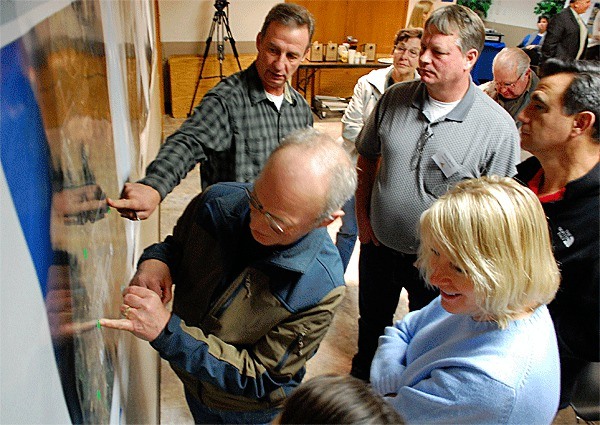The only common sentiment to come out of a public workshop geared toward gathering ideas about where to build Oak Harbor’s proposed wastewater treatment plant Monday was “not in my back yard.”
Green stickers passed out to the crowd to stick on a map of the city showed a wide variety of preferences, but most were well away from urban areas. The largest concentration of stickers were in empty fields on the Seaplane Base along East Pioneer Road.
Robyn Kolaitis, a Dillard Lane resident, said after the workshop that it’s not a verdict that was especially surprising. No one wants to see or smell a treatment plant in the middle of town, she said. Personally, she is hoping the city abandons any thought of rebuilding on the site of its facility at Windjammer Park, which is adjacent to her waterfront neighborhood.
“I don’t think it’s a tourist attraction,” Kolaitis said.
City officials and a representative from Carollo, a national engineering firm hired to create a preliminary facilities plan for the proposed treatment plant, held the workshop largely to get ideas about where to build.
Oak Harbor’s facilities at Windjammer Park and the Seaplane Base are handling the city’s current needs, but they are aged and are on borrowed time. At some point in the not-so-distant future, state regulatory agencies will adopt water quality standards that neither facility is capable of satisfying, according to City Engineer Eric Johnston.
“We’re not there yet, but we’ll get there eventually,” he said.
This is just the beginning of a very long planning process, but the hope is to have the $70 million facility built and operating no later than 2017.
As far as locations go, nothing is “off the table” at this point. If the public wants the facility in a hidden distant corner of the city, modern pumps can make it possible.
“The amount of pumping you can do is only limited by how much you want to spend,” he said.
Along with location suggestions, several people in the crowd asked about the return on their investment. Responding to a question from Oak Harbor resident Jeff Trumbore, Johnston told the crowd that the facility is expected to last for 40 to 50 years and handle both the stricter state standards and the city’s expected population increases.
At least one person, Ron Muzzall of Three Sisters cattle ranch, came to the meeting to find out whether the city is considering reusing the wastewater and solids from the treatment plant to support agriculture. Coupeville is in the process of examining a water reclamation project.
Johnston said the city is looking at various options but that again it comes down to cost. In the case of assisting farmers, it would be the initial cost of infrastructure and the maintained cost of pumping, which would likely be paid by farmers themselves.
Mayor Jim Slowik said later that one strong possibility would be aquifer recharge. As a sole-source aquifer, Whidbey Island could benefit greatly from any recharge possibilities.
Ideas about the facility and potential locations can be submitted online at www.oakharborcleanwater.org, or by calling Johnston at 279-4522.



